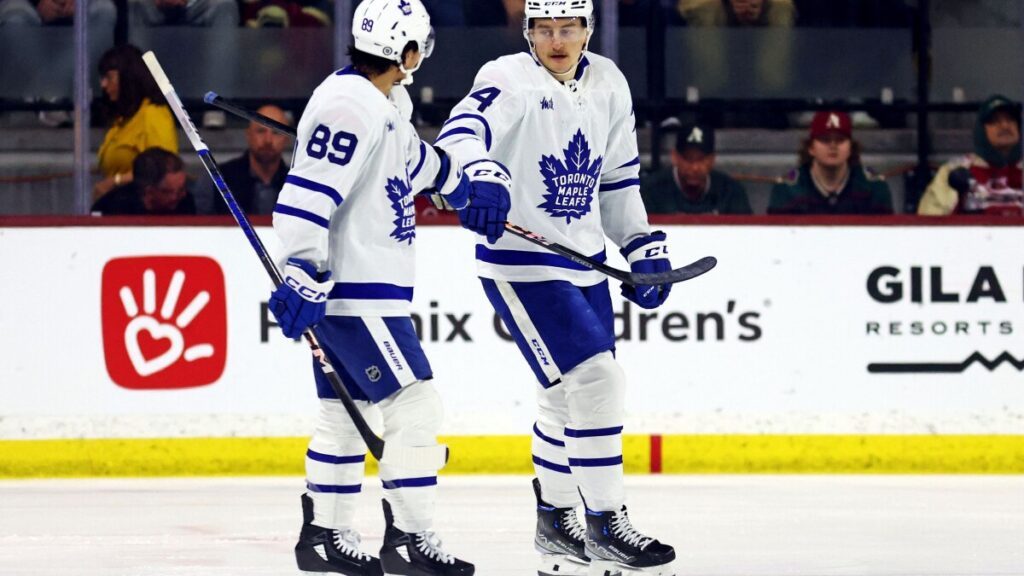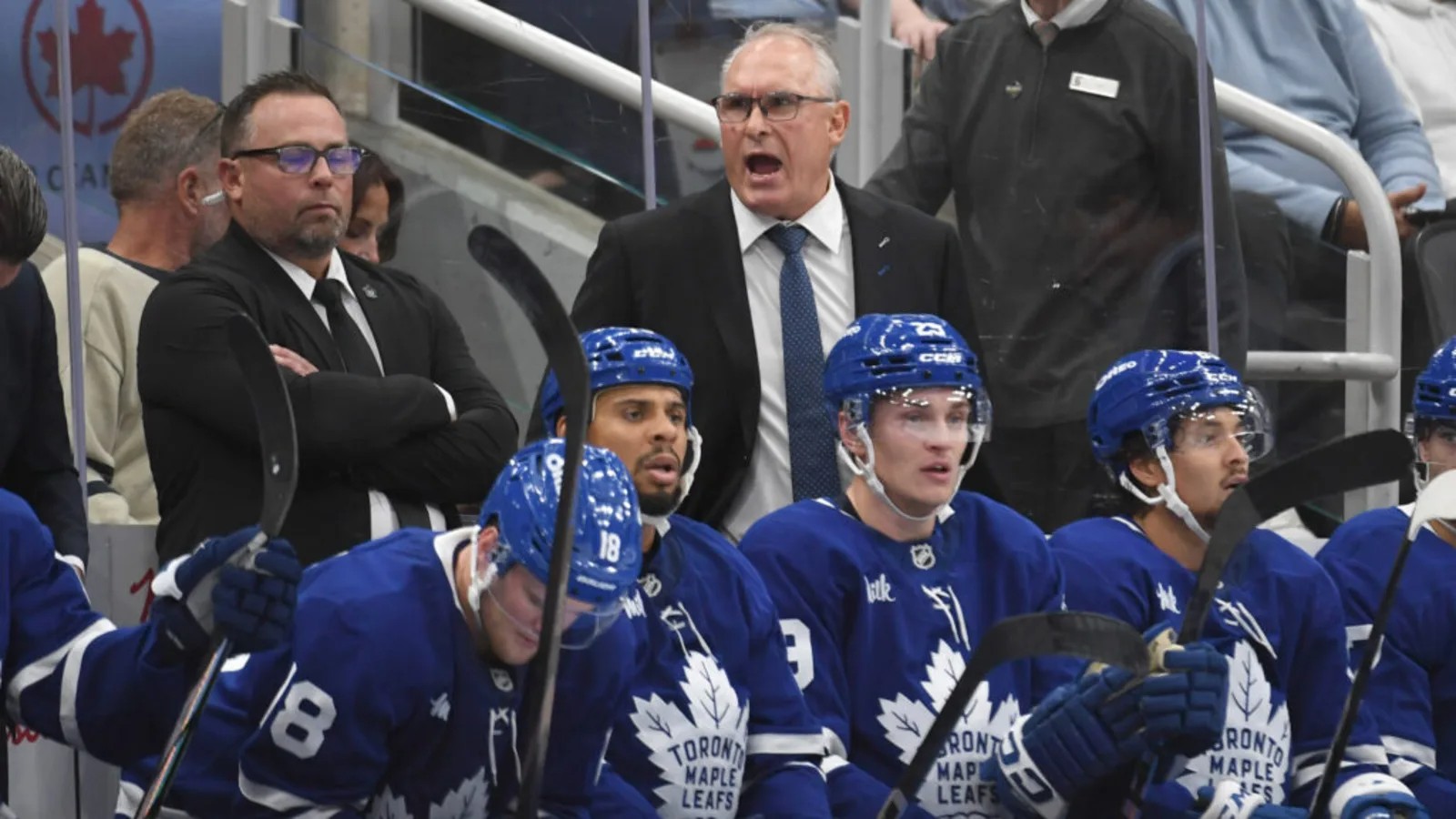New head coach Craig Berube has been adamant that the Maple Leafs embrace north-south hockey.
At the start of training camp, he reiterated it yet again:
We definitely want to be a north-south team, but there is some high-end skill here — more than we had in St. Louis. It is not that we didn’t have skilled players in St. Louis. I am not here to take the sticks out of these guys’ hands, but there has to be an identity of how we want to play, and we want to play a north-south game.”
With the caveat that preseason must always be taken with a grain of salt, we’re beginning to see subtle changes implemented.
Under Sheldon Keefe, the Leafs played methodical, east-west hockey. They regrouped regularly through the neutral zone (allowing opponents to set up defensively but keeping possession in the meantime). Alec wrote a good piece on it in 2023 after the Leafs were eliminated from the playoffs. It neutered some of their speed, and they weren’t even that strong of a puck possession team, finishing 10th and 11th in five-on-five Corsi the past two seasons.
Part of the Leafs’ approach under Keefe was frequently using the middle of the ice on breakouts. They often looked for little touch or area passes to the middle to get the puck into the space in the middle of the ice. We’re seeing far less of this so far; instead, there are plenty of quick-ups on the short-side boards.
Here is a good example of the type of breakout we’ve seen from the Leafs this preseason:
The defense goes five feet up the wall to the winger (in this case, John Tavares) while the far-side winger (Nick Robertson) slashes across the ice, stretching the opposing defense and creating space in the middle of the ice. As a result, Chris Tanev activates as the weak-side defenseman with acres of space as a passing outlet. It’s a very clean breakout out of the Leafs’ zone and through neutral ice with speed.
The “slash” across by the far-side winger is particularly important for the breakout to work. It gives the option to chip the puck by the close opposing defenseman, especially if he pinches, or it creates space if the defenseman backs off.
It wasn’t a clean breakout, but Robertson scored against Montreal by slashing across the ice on a similar breakout structure. The puck is on the wall with the winger, and the center is closely supporting. Robertson slashes behind, grabs the puck, and scores.
We’re also seeing some far-side rims, where the defenseman whips it around the boards behind the net to the far-side winger.
There is nothing fancy here; it’s just around the wall, a little touch pass by the winger to the center, and it’s out. The Leafs would previously reverse this type of play between defensemen to try to lead a more “tape to tape” kind of breakout.
Ultimately, the Leafs hung onto the puck a lot under Keefe and tried to make clean plays up the ice, prioritizing tape-to-tape plays. This isn’t to suggest the Leafs no longer prioritize tape-to-tape passes up the ice, but they are looking for quicker plays to get the puck from their defense to the forwards. Whether it’s hard, far-side rims, or quick chips up off the wall, they aren’t looking for as many style points.
There are a lot of examples in past years of the Leafs being victimized by forcing pucks up the middle or their defensemen holding the puck too long looking to make a play. We will see if they can strike a better balance between clean, crisp breakouts and simply chipping or rimming it to the forwards, who are the strength of the team.
Other Preseason Notes: The Leafs’ new PK structure, goaltending depth, Philippe Myers, Max Pacioretty, Nick Robertson, Easton Cowan, OEL, and Pontus Holmberg

– The early impressions of the penalty kill are that not only is it more aggressive, but it’s structured in a more simple format. The Leafs previously deployed what I called a “T” penalty kill, which was essentially a 1-1-2, and the 2 in that sequence represents the two defensemen. The forward would pressure at the top, and if the puck moved to the half-wall, he would often follow it while the other forward stayed in the middle to block the cross-ice pass. The forwards would switch spots – i.e., the forward in the middle pressures as the other forward switches to the middle.
Now, the PK is more of a standard box/diamond transition, and they pressure whenever there is an opportunity to do so. If they sniff a chance, they will push up to the point, half-wall, or into the corner.
I really liked the play below by Philippe Myers. It’s a bad pass that Kirby Dach can’t handle, so Myers immediately applies pressure, resulting in a turnover and a clear. That’s the type of play the Leafs are looking to pounce on.
– I’ve been impressed with Myers in general, as noted last week. He is 6’6, and at 27, he appears to have grown into his body and isn’t awkward at all for his height. It’s easy to forget that he has 158 NHL games played under his belt. Conor Timmins, for reference, has played 91. Myers would cost $325K less than Timmins. He isn’t as skilled offensively but brings more defensively and physically. The competition on defense is quietly notable between Myers, Timmins, and Marshall Rifai (who has looked solid, if unspectacular). It is a shame Dakota Mermis hurt his jaw. He had a good year in the NHL last season.
– Max Pacioretty had a much tougher second preseason game. One play that highlighted the question about his skating came on a 3v2 in the third period against Montreal.
That’s a clear-cut 3v2 with time and space, which is rare in the NHL, and he’s going up against Morgan Barron, a third-pairing defenseman on his wrong side. It was broken up with ease.
There is no question Pacioretty can still shoot, and he’s clearly big and strong, but I’m not sure he has the speed to make plays or get to the right spots consistently. The domino effect of this roster spot is not just Pacioretty vs. Kampf or a bottom-six checker but the opportunities up the lineup alongside top players. I think Nick Robertson and Bobby McMann would do a better job of cashing in.
In the game against Montreal, for example, Pacioretty played on the top power-play unit over Robertson. Is that really the best choice there? But veterans with a pedigree in the league, such as Pacioretty, will receive looks in those spots if they are on the roster. We will see if his skating improves in the final preseason games, as veterans usually take longer to get their feet underneath them.
– Matthew Knies put on 10 pounds over the summer, weighing in at 227 to start training camp. He looks strong and can win pucks back with ease, but he was already very strong and generally capable of that. Knies has had a good preseason, and they’ve tested him away from Matthews and Marner (which is great), but he does look a bit slower following the weight gain. I am curious to see how it comes together for him overall, as many will remember when Luke Schenn was in a similar situation years ago, although Schenn added a lot more weight than Knies has.
– Not that he needs to prove anything in the preseason or even the first few months of the regular season, but Oliver Ekman-Larsson was excellent in his second game following a tough first primer. He is a legitimate puck mover and can shoot the puck, and it’s very noticeable when you see him with the puck on his stick compared to all of the Leafs’ other defensemen save for Rielly. He’s capable of zipping a puck and making a play, qualities they’ve lacked on the blue line. OEL is also lanky and has a long reach that disrupts a lot of plays.
– I noticed Connor Dewar was added to group three in the preseason, so he is skating, but it will presumably take some time for him to be ready to play a game. With that in mind, there is an appeal to Steven Lorentz, who moves well for his size, is defensively responsible, and has flashed ability on the penalty kill. It is a similar role to Dewar, though Dewar is faster and better offensively. Assuming Dewar isn’t ready to start the season, Lorentz is a clear option for filling his role. Once Dewar is healthy, they could combine to form a respectable checking line.
– I like that Craig Berube challenged Nick Robertson to play well again after scoring on Thursday, and Robertson responded with a great game on Saturday in Montreal with a much weaker Leafs roster. Robertson has produced a really good preseason to this point – burying chances, getting involved in the forecheck, handling penalty-killing duties respectably, and driving play up the ice. I’m sure the summer didn’t go how he wanted it to, but he has responded well so far.
– Heading into the offseason, we noted countless times that the Leafs’ best plan in net was to sign a veteran backup with pedigree and a veteran third-stringer in case of injury. They did just that with Anthony Stolarz and Matt Murray, while Dennis Hildeby also looks like a viable NHL option. Whether they have a “guy” come playoff time remains to be seen; Joseph Woll has flashed the ability but needs to stay healthy. But there is the goaltending depth in place to survive 82 games.
– Heading into camp, Berube noted the need to break junior habits regarding Easton Cowan’s push to make the team. Those have shown up for me in some of his attacking plays, like 2v1s, where he has stopped dead still instead of attacking directly and shooting in stride. He did it on a 2v1 and got a shot off, but it didn’t threaten. In Montreal, he essentially passed up a 2v1 by slowing up. He’s also attempting all sorts of saucer passes across the offensive zone. They look great on the rare occasion they connect but often get deflected or miss the mark entirely. Cowan has flashed the potential, but to this point, he hasn’t made the Leafs’ decision particularly difficult.
– It’s been an excellent preseason for Pontus Holmberg so far. He’s strong holding onto pucks and looks far more comfortable playing center. On Thursday, he went 13/18 in the faceoff circle, and on Saturday, he went 10/16. Holmberg is a career 44.3 percent faceoff man, so that would be a huge uptick. He took two big draws in Montreal against Nick Suzuki with the game on the line, winning one and losing the other (quite badly, to be honest). He also beat Christian Dvorak late in the Leafs’ defensive zone in Toronto while holding the lead. His shot is still weak, but the rest of his game shows signs of rounding out.














![John Gruden after the Leafs prospects’ 4-1 win over Montreal: “[Vyacheslav Peksa] looked really comfortable in the net… We wouldn’t have won without him” John Gruden, head coach of the Toronto Marlies](https://mapleleafshotstove.com/wp-content/uploads/2025/09/gruden-post-game-sep-14-218x150.jpg)


















